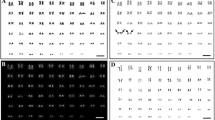Abstract
Study of aneuploidy in spats of Ostreidae (Bivalvia). Chromosomes of cells from gill tissue of juveniles (5–10 mm) from four different populations of Ostrea edulis and five different populations of Crassostrea gigas were examined in order to study aneuploidy and its significance. Mitotic chromosome counts were made for a sample of spats in each population. Cells with the normal diploid complement (2n=20) and with aneuploid complements (2n different from 20) were scored. The total percentage of aneuploid cells in the studied populations of the two species varies from 9% to 34%. Individual patterns of aneuploidy were examined in three populations of Crassostrea gigas. Some animals showed only normal diploid cells, others having both normal and aneuploid cells in variable proportions. The relationship between aneuploidy and growth rate was studied in experimental spats. Mitotic chromosome counts were made on individuals from two groups of animals: the first group was collected at a precise date at a control size of 8 mm, the second group reaching the same size of 8 mm only one month later. The percentage of animals showing aneuploid cells is much greater in the second group. There is a relationship between occurrence of aneuploid cells and growth rate. The karyotypes of 18 aneuploid sets of Ostrea edulis from different spats were analyzed. Chromosome loss was observed only in the submetacentric chromosome pairs. This loss of chromosomes could have an effect on the percentage of homozygotes observed in electrophoregrams. Thus, the percentage of homozygotes would be higher in juveniles showing the greatest number of aneuploid cells. An excess of homozygosity (=heterozygote deficiency) has been reported at a number of enzyme loci in over two dozen bivalve species (including Ostrea and Crassostrea). We suggest the hypothesis that this excess of homozygosity could be related to the occurrence of aneuploid cells. The relationship between aneuploidy and growth rate may prove to be a genetic factor of importance for oyster culturing.
Similar content being viewed by others
References
Ahmed, M. & Sparks, A. K., 1967. A preliminary study of chromosomes of two species of oysters (Ostrea lurida and Crassostrea gigas). J. Fish. Res. Bd. Canada 24: 2155–2159.
Ahmed, M. & Sparks, A. K., 1970. Chromosome number, structure and autosomal polymorphism in the marine mussels Mytilus edulis and Mytilus californianus. Biol. Bull. mar. Biol. Lab. Woods Hole 138: 1–13.
Bayne, B. L., 1983. Physiological ecology of marine molluscan larvae. In: N. Verdonk, J. A. W. Van den Biggelaar and A. S. Tompa (eds.), The Mollusca. pp. 299–337.
Beaumont, A. R. & Gruffydd, T. T., 1974. Studies on the chromosomes of the scallop Pecten maximus (L.) and related species. J. mar. biol. Ass. U.K. 54: 713–718.
Bond, D. J. & Chandley, A. C., 1983. Aneuploidy. Oxford monographs on medical genetics. Oxford University Press, pp. 198.
Diehl, W. J. & Koehn, R. K., 1985. Multiple-locus heterozygosity, mortality and growth in a cohort of Mytilus edulis. Mar. Biol. 88: 265–271.
Dixon, D. R., 1982. Aneuploidy in mussel embryos (Mytilus edulis L.) originating from a polluted dock. Mar. Biol. Lett. 3: 155–161.
Fraser, L. R. & Maudlin, T., 1979. Analysis of aneuploidy in first-cleavage mouse embryos fertilized in vitro and in vivo. Environ. Health Perspect. 31: 141–149.
Koehn, R. K. & Gaffney, P. M., 1984. Genetic heterozygosity and growth rate in Mytilus edulis. Mar. Biol. 82: 1–7.
Koehn, R. K., Milkman, R. & Mitton, J. B., 1976. Population genetics of marine pelecypods. IV. Selection, migration and genetic differentiation in the blue mussel Mytilus edulis. Evolution 30: 2–32.
Koehn, R. K., Perez, J. E. & Merrit, R. B., 1971. Esterase enzyme function and genetical structure of populations of the freshwater fish, Notropis stramineus. Am. Natur. 105: 51–69.
Longwell, A. C., Stiles, S. S. & Smith, D. G., 1967. Chromosome complement of the american oyster Crassostrea virginica as seen in meiotic and cleaving eggs. Can. J. Gen. Cyt. 9: 845–856.
Maliet, A. L., Zouros, E., Gartner-Keplay, K. E., Freeman, K. R. & Dickie, L. M., 1985. Larval viability and heterozygote deficiency in populations of marine bivalves: evidence from pair matings of mussels. Mar. Biol. 87: 165–172.
Singh, S. M. & Green, R. H., 1984. Excess of allozyme homozygosity in marine molluses and its possible biological significance. Malacologia 25(2): 569–581.
Singh, S. M. & Zouros, E., 1978. Genetic variation associated with growth rate in the american oyster (Crassostrea virginica). Evolution 33(2): 342–353.
Thiriot-Quiévreux, C. & Ayraud, N., 1982. Les caryotypes de quelques espèces de Bivalves et gastéropodes marins. Mar. Biol. 70: 165–172.
Thiriot-Quiévreux, C., 1984. Les caryotypes de quelques Ostreidae et Mytilidae. Malacologia 25(2): 465–475.
Thiriot-Quiévreux, C., 1985. Analyse comparée des caryotypes d'Ostreidae. Cah. Biol. Mar. 25: 407–418.
Zouros, E. & Foltz, W., 1984. Possible explanation of heterozygote deficiency in Bivalve molluscs. Malacologia 25(2): 583–592.
Author information
Authors and Affiliations
Rights and permissions
About this article
Cite this article
Thiriot-Quiévreux, C. Etude de l'aneuploïdie dans différents naissains d'Ostreidae (Bivalvia). Genetica 70, 225–231 (1986). https://doi.org/10.1007/BF00122190
Received:
Accepted:
Issue Date:
DOI: https://doi.org/10.1007/BF00122190




